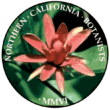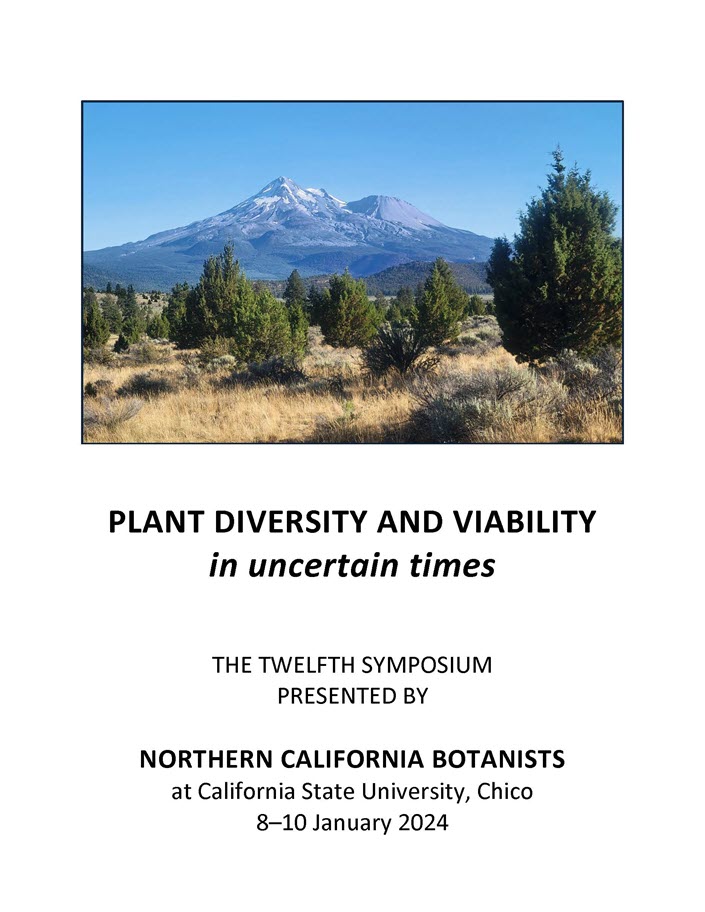Plant Diversity and Viability in Uncertain Times
Northern California Botanists hosted their 12th botanical symposium on January 8-9 on the campus of California State University in Chico. Optional workshops/field trips were held on Wednesday, January 10. This event included both In-Person and Virtual options. Sessions included: Climate Change, Bryophytes, Vegetation Classification, New Discoveries, Meadow and Grassland Restoration, Local Floras, Now the Good News, and Lightning Talks. A dedicated Poster Session was held on Tuesday morning. We will be posting videos of the talks in the near future. Scroll to the Poster Session section for pdfs of many of the posters presented at the Symposium.
We couldn't do this without our Sponsors! Thank you to everyone who donated and helped put the 2024 Symposium on.
Congratulations to our Student Poster Winners!
- First Place - Charlotte Miranda, San Jose State University
- Second Place - Amy White, University of California, Merced
- Third Place - Daniel Toews, University of California, Merced
Symposium Presentations
Videos of many of the talks are available below by clicking on the talk title. Click on the PDF to view a copy of their presentation. Abstracts of the talks can be found in the Symposium Program starting on Page 9.
Session 1: Climate Change
Session Chair: Russell Huddleston, Environmental Protection Agency, Region 9
- Monitoring alpine plants as climate changes, a GLORIA Great Basin update. PDF
Jim and Catie Bishop, GLORIA Great Basin - Subalpine and alpine plant community turnover in Yosemite National Park following 30 Years of climate warming. PDF
Rachel Friesen, Cal Poly, San Luis Obispo - Climate change and vernal pools on the Modoc Plateau.
Kyle Merriam, U.S. Forest Service - Phenological shifts in flowering and plant pollinator interactions. PDF
Laura Lampe, California State University, Chico
Session 2: Bryophytes
Session Chair: Ben Carter, Director of the Carl W. Sharsmith Herbarium (San Jose State University and Drought Mitigation Specialist, California Department of Fish and Wildlife
- New insights into the evolutionary history and floristics of California’s non-vascular plants. PDF
Ben Carter, Director of the Carl W. Sharsmith Herbarium and Associate Professor, San Jose State University - Species delimination of a moss clade in a global hotspot for Bryophyte diversity. PDF
Larke Reeber, San Jose State University - Bryophyte flora of Henry W. Coe State Park. PDF
John McLaughlin, San Jose State University - The relationship between sexual condition, sex chromosomes, and ploidy in Syntrichia. PDF
Jenna Ekwealor, Assistant Professor, San Francisco State University
Session 3: Vegetation Classification
Session Chair: Teresa Sholars, Professor Emeritus, College of the Redwoods
- Nearing the finish-line: A path forward to completing a state-wide vegetation classification and fine-scale map. PDF
Rachelle Boul, California Department of Fish and Wildlife - Updated vegetation concepts for Northern California Coast Ranges and the Modoc Plateau. PDF
Betsy Harbert and Jaime Ratchford, California Department of Fish and Wildlife - A few observations of herbaceous plant communities from the fascinating San Joaquin Desert Region of the Central Interior Coast Ranges. PDF
Alex Hubner, Botanist & Horticulturist, UC Santa Cruz Arboretum Native Plant Program - Fine-scale vegetation mapping & inventory across the Greater San Francisco Bay Area, California: With a focus on Alameda & Contra Costa counties. PDF
Julie Evens, California Native Plant Society
Session 4: New Discoveries
Session Chair: Len Lindstrand III, Sierra Pacific Industries
- Distribution and discovery of Northern California bryophytes. PDF
Jim Shevock, California Academy of the Sciences - Looking for one thing and finding another: Phylogenomic study of Eriodycton capitatum (Namaceae) resolves the placement of the enigmatic Nama rothrockii. PDF
Matt Guilliams, Santa Barbara Botanic Garden - New taxa from the Marble Mountains.
Dana York, Botany Research Associate, California Academy of the Sciences - A new Lewisia from the Southeastern Klamath Ranges. PDF
Jessica O’Brien, Sierra Pacific Industries
Session 5: Lightning Talks
Session Chair: Kristen Kaczynski, California State University, Chico
- Response of Layne’s butterweed (Packera layneae) to fuels treatments, high severity fire, and fire suppression activities. PDF
Chelsea Morgan, Tahoe National Forest - The boom and bust of vernal pool rare plant populations.
Joy Baccei, U. C. Natural Reserve System - Updates on the flora of the Snow Mountain Wilderness Project. PDF
Jen Pagel, San Francisco State University - Recent additions to CESA. PDF
Kristi Lazar, California Department of Fish and Wildlife - Plant pollinator relationships at the Pine Hill Preserve PDF
Landon Eldridge, Bureau of Land Management - Sierra Nevada backpack botany. PDF
Michael Uhler, Regional Parks Botanic Garden - Historical trends in the emergence of the ephemeral geophytes, Dicentra uniflora and Dicentra pauciflora (Papaveraceae) in Northen California as indication of climate warming. PDF
Hal Mackey, Retired Environmental Scientist
Keynote Speaker
- John Vollmar, President/Principal Ecologist, Vollmar Natural Lands Consulting, Inc.
Title of Talk: “The Heart of Conservation - Engaging Human Passion for Conservation Success” PDF
Session 7: Grassland Restoration
Session Chair: Jane Van Susteren, California Board of Forestry
- Lessons learned from long-term restoration outcomes of restored coastal prairies. PDF
Justin Luong, Cal Poly, Humboldt - Thatch Management Using Mowing and Grazing to Benefit the Behren's endangered butterfly (Speyeria zerene behrensii), Manchester, California, USA. PDF
Terra Fuller, Sonoma Mendocino Coast District, California State Parks - Restoration of meadows in the Sierra. PDF
Evan Wolf, Evan Wolf, LLC - Restoration of plant/pollinator mutualisms in serpentine grasslands. PDF
Rebecca Nelson, Harrison Lab, University of California, Davis
Session 8: Local Floras
Session Chair: David Magney, Principal Biologist, Althouse and Meade, Inc.
- Methods to develop locally rare plant lists using Ventura Flora as an example. PDF
David Magney, Principal Biologist, Althouse and Meade, Inc. - Checklist of the flora and locally rare taxa of San Mateo County. PDF
- Toni Corelli, Santa Clara Valley Chapter, California Native Plant Society
- Inspirations and development of A Flora of Napa County with some lessons learned. PDF
Jake Ruygt, Napa Botanical Survey Services - Built on a legacy—Second edition of Vascular Plants of San Luis Obispo County, California. PDF
David Keil, Professor Emeritus, Cal Poly, San Luis Obispo
Session 9: Now the Good News
Session Chair: Joe Silveira, U.S. Fish and Wildlife Service, Retired
- Vegetation trends and cycles in the fire-prone landscapes of Lake, Napa, and Sonoma counties. PDF
Arthur Dawson, Baseline Consulting - Floodplain restoration on disconnected gravel bars in the Sacramento watershed. PDF
Michael Rogner, Associate Science Director, River Partners - Adventures and discoveries during 30 years of conservation work at Fort Ord National Monument (1993 – 2023). PDF
Bruce Delgado, Biologist, Fort Ord National Monument, Bureau of Land Management and Aubrie Heckel, Botanist, Fort Ord National Monument, Bureau of Land Management - Frank & Joan Randall Preserve: botany, vegetation & conservation overview of the 82,000 acres at the convergence of the Tehachapi and Southern Sierra Mountain ranges. PDF
Zach Principe, Project Director, The Nature Conservancy and Neal Kramer, Kramer Botanical
Poster Session
Below are links to some of the posters presented at the symposium. Poster abstracts can be found in the Symposium Program starting on Page 23, listed alphabetically by presenting author name.
Fens, Fire, and Forest Management: Effects of the Dixie Fire on Sierra Nevada Fens. Bilodeau, C., Adelstein, E., Keever, M., Rodriguez, K., Jurjavcic, N., and Butler, N.
Eliminating Foliar Endophytic Fungi from Quercus lobata Leaves for Studying Priority Effects in Leaf Litter Fungal Communities. Avila, D., Bolinas, T., and Cobian, G. M.
Challenges in Identification of Tuolumne iris (Iris hartwegii ssp. columbiana), mariposa clarkia (Clarkia biloba ssp. australis), and Small’s southern clarkia (Clarkia australis) on the Stanislaus National Forest, Tuolumne County. Brillante, P., Beyerl, T., Violett, S., and Whittington, T.
Landscape Level Botanical Management in an Industrial Timberland Environment: Development of the County Line Botanical Management Area. Cashman, G., Lamphear, D., Budesilich, M., and Shedlock, A.
Convergence and Divergence in Restored Riparian Overstories and Understories along the Sacramento River, California. Constantz, B., Holl, K., and Stella, A.
Fierce Urgency: On the Fly Development of a Coast Redwood Drought-Response Monitoring Program on a College Campus. Geary, M., and West Valley College Plant Biology Students.
Special-Status Plants and their Relationships with Roadsides. Kang, H.
Corallorhiza trifida, Rediscovered in the Lake Tahoe Basin, after a Century. Kieffer, C.
A Habitat Suitability Model for Monotropa uniflora (Ghost pipe) on Green Diamond Resource Company Timberlands in North Coastal California. Lamphear, D., Cashman, G., Budesilich, M., and Shedlock, A.
The Influence of Drought and Warming on Lupinus nipomensis: Implications for Survival, Morphology, Reproduction, and Microbial Communities. Nguyen, P., Luong, J., Meyer, R., and Loik, M.
A Prickly Pappose Tarplant Success Story: Disturbance in the Delta. Rodriguez, K., Bilodeau, C., Applequist, E., and Keever, M.
Thank you to our Symposium Sponsors!
- Ascent Environmental, Inc.
- Bureau of Land Management
- California Botanical Society
- California Department of Fish and Wildlife
- California Invasive Plant Council (Cal-IPC)
- California Native Grasslands Association
- California Native Plant Society (CNPS) - State Office
- California Native Plant Society (CNPS) - Dorothy King Young Chapter
- California Native Plant Society (CNPS) - Mount Lassen Chapter
- California Native Plant Society (CNPS) - North Coast Chapter
- California Native Plant Society (CNPS) - Sacramento Valley Chapter
- California Native Plant Society (CNPS) - Shasta Chapter
- Carol Witham
- ECORP
- Friends of the Ahart Herbarium
- Halkard Mackey
- Hedgerow Farms
- Heritage Growers / River Partners
- HDR, Inc.
- Julie Kierstead
- Kleinfelder
- Lawrence Janeway
- Linnea Hanson
- Madrone Ecological Consulting
- Nomad Ecology
- Santa Barbara Botanic Garden
- Sierra Pacific Foundation
- Dr. Stephen Rae
- Stillwater Sciences
- Tom Parker
- WRA, Inc.
2024 Keynote Speaker: John Vollmar
The 2024 Symposium Keynote Speaker was John Vollmar. John is the President/Principal Ecologist for Vollmar Natural Lands Consulting. The subject of his talk was “The Heart of Conservation - Engaging Human Passion for Conservation Success.”
Beginning with seed funding from the U.S. Environmental Protection Agency and East Merced Resource Conservation District in 1998, John Vollmar has worked over the past 25 years to conserve the expansive and rich vernal pool landscapes of eastern Merced County. These mostly intact landscapes are contiguous with the vast blue oak savannas and woodlands of western Mariposa County. Together, they create a Great Valley-Sierra Nevada Foothill block of mostly private natural lands connecting with two national forests, Yosemite National Park, and beyond. Protecting Merced County’s vernal pool-grasslands is an essential component to conserving a contiguous, functional habitat corridor from the Great Valley, through the Sierra Nevada, to the Great Basin. But, how do we achieve meaningful, landscape-scale conservation, especially in areas with numerous private landowners? Working with landowners, land trusts, environmental consultants, mitigation buyers, and others, Mr. Vollmar has gained a unique perspective on how we achieve such conservation over time, and the critical role of human passion at its core. Building on this understanding, and analyzing data on geologic formations, rare species occurrences records, predicted habitat modeling for these species, and other factors, he and colleagues at Vollmar Natural Lands Consulting recently published a reference manual and user’s guide for the ‘Conservation of Great Valley Vernal Pool Landscapes.’ It is intended to inspire, motivate, and guide ongoing conservation of these special habitats throughout the Great Valley. Mr. Vollmar will present a history of his work in eastern Merced County, key lessons learned along the way, and a walk-through of his recently published conservation guide as a model for others to consider in their pursuit of conservation interests, in the Great Valley and elsewhere.

